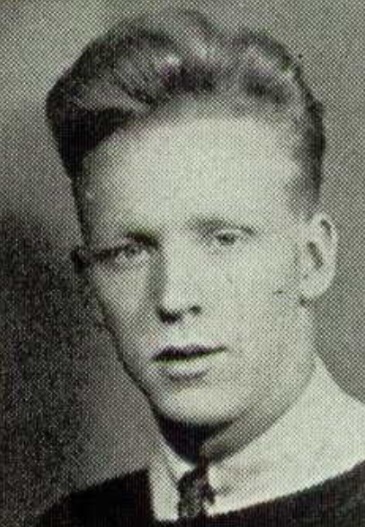Lieutenant Dennis J. Stack
Lieutenant Dennis John Stack US Army. He was born on February 16, 1917 in Chicago Illinois. He graduated from Roosevelt High School in Chicago Illinois in 1936. At the time of his enlistment he was 5 foot 9 inches weighed 160 pounds had blue eyes and blonde hair. He served in Company L, 337th Infantry Regiment, 85th Infantry Division. Sergeant Christos H, Karaberis served under him when Karaberis earned the Medal of honor and below is his account of the events. Stack died on January 19, 2003, in San Francisco, California at the age of 85. He was Awarded the Combat Infantry Badge, the Bronze Star Medal with V and Oak Leaf cluster, The American Theater of operations, the European Theater of Operations Medal ETO with 2 battle star, the World War Two Victory Medal.
War Department, Press Releases
The story of how the courage of one Infantryman, who went on a rampage with a submachinegun, contributed to the capture of Casoni di Romagna hill in Italy wag unfolded today in an announcement by the War Department,
The heroic Doughboy is Sergeant Christos H, Karaberis of Hillsboro, New Hampshire, known to his buddies in the 85th Infantry (Custer) Division and more particularly to the Germans as a “one—man wave of destruction.”
Sergeant Karaberis is credited with capturing five German machinegun positions and 21 prisoners, and killing eight enemy soldiers the night of October 1, 1944.
In a detailed account of his heroic action, the young Infantryman platoon leader, 1st Lieutenant Dennis J, Stack, told how Sergeant Karaberis singlehandedly cleared a ridge studded with enemy machinegun emplacements, “to tear a hole in the German lines through which his battalion and regiment were able to pour without a single casualty.”
“Company L had received orders to attack and capture Casoni di Romagna hill, which was heavily defended by the enemy, as was the ridge leading to this hill from the south,” the officer continued. “After crossing numerous gullies and deep draws the company was pinned down by enemy fire on the eastern slope of the ridge.
“The company’s position was 4000 yards from the objective, Machineguns, machine pistols, rifles and mortars on the ridge dropped a curtain of devastating fire between the company and the enemy—held high ground.”
The Infantry assaulters were able to move only 75 to 100 yards when they were halted by German machinegun fire from emplacements covering all approaches to the ridge, both frontally and on the flanks, according to Lt. Stack.
“Sergeant Karaberis immediately realized that the machineguns which were impeding our advance must be wiped out, the officer said. “Without a moment’s hesitation and knowing the danger that lay ahead of him, the sergeant turned over control of his squad to the assistant squad leader, shouting: ”Have the squad follow me. I’ll get ’em myself.
Then, according to Lt. Stack, the New Hampshire Doughboy crept forward with his submachine gun as enemy fire cracked and whined around him and bullets ricocheted off the rocks affording him cover.
Sergeant Karaberis worked his way to the rear of the first German machinegun nest and attacked it, taking its entire crew of eight men prisoners. Turning over the prisoners to his squad, he then proceeded under murderous fire to the second nest, 350 yards away. He charged the position in a crouching, weaving run, blazing away with his tommy—gun and killing four of the crew. A fifth German threw up his hands in terror and surrendered.
“Keep following me, he shouted back to his squad, as he began a 500-yard trek over the rocky slope to silence a third Nazi machinegun nest. A short burst from his tommy—gun brought the quick surrender of a crew of four men, including one officer. Turning over the new prisoners to his squad, Sergeant Karaberis struck out again.
“Alternately creeping and crawling, and madly dashing across open spaces, the sergeant worked his way to the next Nazi position, Lt. Stack revealed. “Sweeping the position with a series of furious bursts from his tommy—gun, he charged. Four of the German crew lay dead when the sergeant sprang upon the three remaining survivors, taking them prisoners.”
Then the fearless Doughboy was treated to an unusual sight in the semi—light of the early morning.
Six Germans in an adjoining machinegun nest, convinced they were being attacked by an overwhelming force, appeared in the mist with their hands up and stood cowering before the sergeant’s tommy—gun.
Besides the commendation of his platoon leader, Sergeant Karaberis, the son of Arthur Karaberis, of 431 Cypress Street in Hillsboro, also received high praise from Major General John B. Coulter of the 85th Division, who declared:
“His brilliant leadership and willing self—sacrifice offered the finest example to the men of his entire regiment, and by voluntarily meeting and overcoming one known hazard after another, he contributed beyond measure to the successful accomplishment of his regiment mission.
in the U.S. WWII Draft Cards Young Men, 1940-1947
in the U.S., Social Security Applications and Claims Index, 1936-2007
Roosevelt High School 1936 Yearbook
U.S., War Department, Press Releases and Related Records, 1942-1945
